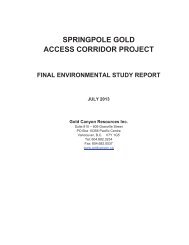Malawi NI 43-101 - December 2011 - Gold Canyon Resources Inc.
Malawi NI 43-101 - December 2011 - Gold Canyon Resources Inc.
Malawi NI 43-101 - December 2011 - Gold Canyon Resources Inc.
- No tags were found...
Create successful ePaper yourself
Turn your PDF publications into a flip-book with our unique Google optimized e-Paper software.
36The ion-adsorption REE deposits can only be processed chemically.Extraction is by ion exchange using a variety of common chemicals such as thesulphate, nitrate or chloride of ammonium, which provide the NH 4+ cations toreplace REE ions, but Na+, K+ and other cations are also effective. The REEmay be extracted by batch-leaching, by heap-leaching or can be extracted by insitu leaching (“ISR”). The leached REE are commonly recovered from theleachate by precipitation with oxalic acid or ammonium bicarbonate.The principal features of the ion-adsorption REE deposits are summarizedbelow1 The REE deposits are soils developed in tropical areas with high rainfall bylong-continued weathering, generally on granite bedrock.2 Much of the REE is derived from weathered accessory minerals, naturallyleached by ground waters in the upper soils (A layer) and redeposited at greaterdepth where it is loosely bound to clays, generally in the B soil layer but also inthe C layer.3 Although ion-adsorption deposits vary in their composition of individual REE,they tend to have a distinctly different distribution than other sources such ascarbonatites, with less light REE, and higher proportions of the valuable mid-REEand heavy REE. They also often have a Ce deficiency and a smaller Eudeficiency.4 REE grades are low (0.05-0.35 % total RE oxide), but the soils can be minedby relatively inexpensive shallow surface excavations or by in situ recovery.5 In contrast to other types of REE deposits, which commonly require complexand expensive processing, REE in ion-adsorption deposits can be extracted bysimple leaching of common chemicals. The amount recoverable is commonly 60to 90% of the total REE in the soil.






